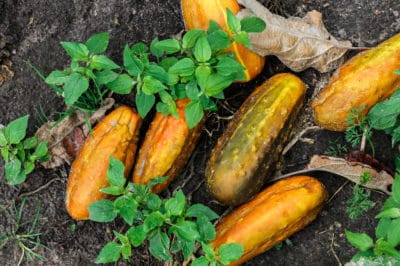What Causes Yellow Cucumbers
The most common reason for cucumbers turning yellow is that they’ve been allowed to ripen on the vine. As cukes get older, the chlorophyll responsible for their usually green color begins to fade, revealing the yellow pigment beneath — just like green leaves that change to red, orange or yellow in fall. Cukes also become yellow from:
- Overwatering. It robs the soil of essential minerals, including nitrogen and calcium. In the case of calcium deficiency, the fruits yellow long before it’s large enough to eat.
- A viral disease. The skin of cukes infected with cucumber mosaic virus gradually becomes yellowish-green with deeper-green mottling. They won’t give you the virus, but they’re often bitter.
Expert gardener’s tips: Some cucumber varieties naturally produce creamy to pale-yellow fruit that’s perfectly fine to eat. One such example is ‘Salt and Pepper.’ At the perfect picking stage, its cukes are pale yellow and peppered with tiny black spines.
How to Prevent Yellow Cucumbers
Knowing when to pick your cucumbers prevents the major cause of yellowing:
- Pick slicing cucumbers at 7 to 9 inches.
- Pick pickling cucumbers at 2 inches to make sweet pickles or gherkins and at 3 to 4 inches for dills.
- Pick burpless cucumbers at about 1.5 inches around.
Expert gardeners tip: Once the female cuke flowers are pollinated, check the progress of your baby cukes daily. Most will be ready to harvest in 8 to 10 days.
Avoid Overwatering
Even in prolonged dry weather, cucumbers need just 2 inches of water each week. The rest of the time, decrease that to 1 inch of water weekly, including rainfall. This amounts to between six and 12 gallons of water for every 1 square foot of soil. For the best results, water slowly and deepy in two weekly sessions.
Stop CMV
To stop cucumber mosaic virus. drape your cuke seedlings with permeable fabric row covers at planting. Light enough for the growing plants to lift, they let air, light and moisture in while keeping virus-transmitting aphids away.
